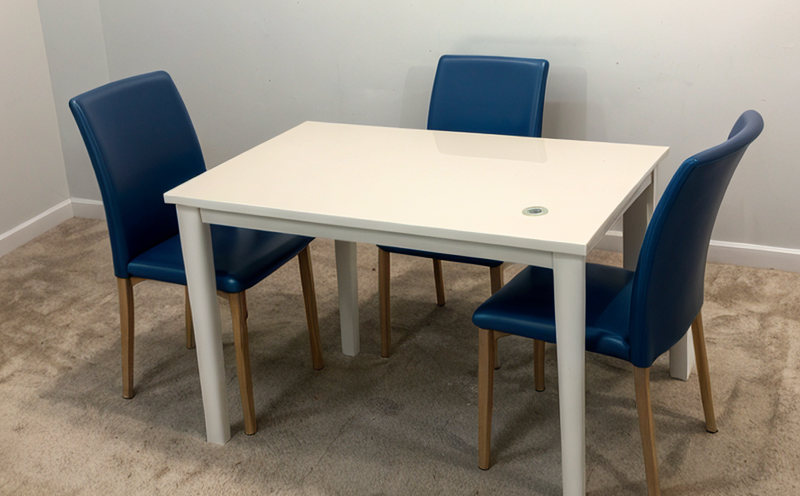DIN EN ISO 604 Compression Testing of Interior Plastics
Compression testing is a critical step in ensuring that furniture and interior plastics meet stringent safety, durability, and performance standards. The DIN EN ISO 604 standard provides guidelines for compression testing of plastic materials used in interior applications such as automotive interiors, office furniture, and home furnishings.
This test evaluates the resistance to deformation or crushing under applied pressure. It is essential for manufacturers to ensure that their products can withstand the stresses encountered during use without compromising safety or integrity. Compliance with this standard ensures product reliability and meets regulatory requirements across various industries.
The testing process involves placing a specimen of plastic material into a compression machine, which applies force uniformly until failure occurs. The test results provide valuable insights into the mechanical properties of the plastic, including elasticity, resilience, strength, and modulus of elasticity.
For accurate and reliable testing, it is crucial to follow strict procedures for sample preparation. This includes selecting appropriate specimens that represent the material's intended use in furniture or interior applications. Proper conditioning of samples ensures consistent results by eliminating any moisture content variations.
The compression machine used should meet specific technical requirements outlined in the standard, ensuring accurate and repeatable measurements. Instrumentation plays a vital role in achieving precise outcomes during testing; therefore, maintaining calibration standards is essential for obtaining valid data.
Once testing has been completed, detailed reports must be generated based on the collected information from each compression test. These documents should include relevant parameters such as force applied, displacement rate, temperature conditions (if applicable), and ultimate load capacity before failure occurs.
In addition to meeting internal quality control standards within manufacturing facilities, compliance with DIN EN ISO 604 can also help businesses comply with international regulations governing product safety. For instance, many countries require manufacturers exporting furniture or automotive components into their markets to adhere to these specific testing protocols.
By adhering strictly to the procedures prescribed by DIN EN ISO 604, companies demonstrate their commitment to producing high-quality products that not only meet but exceed industry expectations regarding durability and safety. This attention to detail can translate directly into enhanced customer satisfaction, improved brand reputation, and increased market competitiveness.
| Standard Name | Description |
|---|---|
| DIN EN ISO 604-1 | General principles and test methods for compression testing of plastic materials. |
| DIN EN ISO 604-2 | Compression testing apparatus and devices used in conjunction with DIN EN ISO 604-1. |
Competitive Advantage and Market Impact
- Ensures consistent product performance across all batches produced by adhering strictly to international standards.
- Reduces risk of non-compliance with regulatory requirements, thereby avoiding costly fines or recalls.
- Promotes trust among consumers who value safety and quality when purchasing furniture made from plastic materials.
- Achieves higher levels of customer satisfaction through reliable products that meet expectations regarding durability and reliability.
Use Cases and Application Examples
The DIN EN ISO 604 compression testing method finds application in various sectors where interior plastics are utilized. These include automotive interiors, office furniture manufacturing, home furnishings, and even medical equipment.
In the context of automotive interiors, this test helps manufacturers ensure that seat cushions or door panels can withstand repeated use without deforming significantly over time. For office furniture makers, it allows them to verify whether their desk chairs will maintain their shape after prolonged periods of sitting on them by employees.
When applied to home furnishings like couches and armchairs, this testing ensures that these items remain comfortable and do not sag excessively under normal load conditions. Additionally, when used in conjunction with other tests (such as thermal cycling), it helps assess how well the plastic components will perform over extended periods.
Medical equipment manufacturers also benefit from performing compression tests according to DIN EN ISO 604 standards because they need to guarantee that their products are safe and effective even when subjected to high loads or continuous use. By adhering strictly to these guidelines, companies can demonstrate their commitment to producing top-notch medical devices that meet the highest safety standards.
Overall, compliance with DIN EN ISO 604 compression testing serves as a benchmark for quality assurance in industries where interior plastics play an integral role. It helps manufacturers produce reliable products that are both safe and durable while also fostering trust among consumers who value these qualities when making purchasing decisions.





